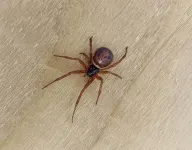(Press-News.org) PULLMAN, Wash. -- A new fungus strain could provide a chemical-free method for eradicating mites that kill honey bees, according to a study published this month in Scientific Reports.
A team led by Washington State University entomologists bred a strain of Metarhizium, a common fungus found in soils around the world, to work as a control agent against varroa mites. Unlike other strains of Metarhizium, the one created by the WSU research team can survive in the warm environments common in honey bee hives, which typically have a temperature of around 35 Celsius (or 95 F).
"We've known that metarhizium could kill mites, but it was expensive and didn't last long because the fungi died in the hive heat," said Steve Sheppard, professor in WSU's Department of Entomology and corresponding author on the paper. "Our team used directed evolution to develop a strain that survives at the higher temperatures. Plus, Jennifer took fungal spores from dead mites, selecting for virulence against varroa."
Jennifer Han, a post-doctoral researcher at WSU, led the breeding program along with WSU assistant research professors Nicholas Naeger and Brandon Hopkins. Paul Stamets, co-owner and founder of Olympia-based business Fungi Perfecti, also contributed to the paper. Stamets is a fungi expert, well-known for using several species in applications ranging from medicine to biocontrol.
Varroa destructor mites, small parasites that live on honey bees and suck their "blood," play a large role in Colony Collapse Disorder, which causes beekeepers to lose 30-50% of their hives each year. The mites feed on bees, weakening their immune systems and making them more susceptible to viruses.
The main tools beekeepers use to fight varroa are chemicals, such as miticides, but the tiny pests are starting to develop resistance to those treatments, Naeger said.
Metarhizium is like a mold, not a mushroom. When spores land on a varroa mite, they germinate, drill into the mite, and proliferate, killing it from the inside out. Bees have high immunity against the spores, making it a safe option for beekeepers.
Stamets, who did some of the initial testing with Metarhizium that showed the fungus couldn't survive hive temperatures, was impressed by the work done by the WSU researchers.
"Science progresses through trial and error, and my technique wasn't economical because of the hive heat," he said. "But Jennifer did enormous amounts of culture work to break through that thermal barrier with this new strain. It's difficult to really appreciate the Herculean effort it took to get this."
Han and Naeger screened more than 27,000 mites for levels of infection to get the new strain.
"It was two solid years of work, plus some preliminary effort," Han said. "We did real-world testing to make sure it would work in the field, not just in a lab."
This is the second major finding to come from WSU's research partnership with Stamets involving bees and fungi. The first involved using mycelium extract that reduced virus levels in honey bees.
"It's providing a real one-two punch, using two different fungi to help bees fight varroa," Stamets said. "The extracts help bee immune systems reduce virus counts while the Metarhizium is a potentially great mite biocontrol agent."
The next step is to seek approval from the Environmental Protection Agency to use Metarhizium on hives used in agriculture. The team must also finalize delivery methods for beekeepers to apply the fungus in hives.
"We hope in 10 years that, rather than chemical miticides, Metarhizium is widely used to control Varroa mites," Sheppard said. "And that the mite problem for beekeepers has been significantly reduced."
The team thinks the methods they developed to evolve Metarhizium for varroa control could be used to improve biocontrol agents in other crop systems as well.
INFORMATION:
The majority of the funding for this work came from private donations from individuals and foundations. Additional funding came from Washington State Department of Agriculture (WSDA) Specialty Crop Block Grant K2531 and the USDA National Institute of Food and Agriculture, Hatch 1007314.
A research group at the University of Córdoba evaluated the commercial mixture formulated in a laboratory and the tank-based mixture of two herbicides to determine which method is more effective in terms of weed control and environmental impact.
In 2017 the company Nufarm Europe proposed to the Higher Technical School of Agricultural and Forestry Engineering (ETSIAM) at the UCO a study of the results of two products having a significant agronomic impact: the herbicides glyphosate and 2,4-D (synthetic auxin). After three years of research, they concluded that the commercial mix produced in the company's laboratories is more effective than manual mixes produced in tanks.
To do this, they used in vivo techniques (tests with greenhouse ...
MAY 26, 2021 -- Researchers from UTSA, the University of Central Florida (UCF), the Air Force Research Laboratory (AFRL) and SRI International have developed a new method that improves how artificial intelligence learns to see.
Led by Sumit Jha, professor in the Department of Computer Science at UTSA, the team has changed the conventional approach employed in explaining machine learning decisions that relies on a single injection of noise into the input layer of a neural network.
The team shows that adding noise--also known as pixilation--along multiple layers of a network provides a more robust representation of an image that's recognized by the AI ...
The Menetries' tiger moth (Arctia menetriesii) is one of the rarest and most poorly studied Palaearctic moth species. Even though its adult individuals are large and brightly coloured, they are difficult to spot, because they aren't attracted to light, they're not active at night, and they fly reluctantly. Currently, the species only inhabits two countries - Finland and the Russian Federation, and is included in the Red Lists of both, as Data Deficient in the former and Vulnerable in the latter.
For 13 years, researcher Evgeny Koshkin of the Institute of Water and Ecology Problems of the Far ...
Men aged 65 and over should monitor their sleep patterns and seek medical advice after a warning from Flinders University experts that disrupted slumber can be linked to cognitive dysfunction.
In a new article published in the Journal of Sleep Research, the Adelaide Institute for Sleep Health research group studied a group of 477 middle-aged and older men's attention and processing speed in relation to their sleep.
The participants from the Florey Adelaide Male Ageing Study undertook cognitive testing and a successful sleep study.
"Less deep sleep and more light sleep is related to slower responses on cognitive function tests," says lead author Jesse Parker. ...
To really appreciate what a team of researchers led by Maksym Kovalenko and Maryna Bodnarchuk has achieved, it is best to start with something mundane: Crystals of table salt (also known as rock salt) are familiar to anyone who has ever had to spice up an overtly bland lunch. Sodium chloride - NaCl in chemical terms - is the name of the helpful chemical; it consists of positively charged sodium ions (Na+) and negatively charged chloride ions (Cl-). You can imagine the ions as beads that strongly attract each other forming densely packed and rigid crystals like the ...
Scientists at Nanyang Technological University, Singapore (NTU Singapore) have developed a new biomaterial made entirely from discarded bullfrog skin and fish scales that could help in bone repair.
The porous biomaterial, which contains the same compounds that are predominant in bones, acts as a scaffold for bone-forming cells to adhere to and multiply, leading to the formation of new bone.
Through laboratory experiments, the NTU Singapore team found that human bone-forming cells seeded onto the biomaterial scaffold successfully attached themselves and started multiplying - a sign of growth. They also found that the risk of the biomaterial triggering an inflammatory response is low.
Such a scaffold could be used to help with the regeneration of ...
The parents of children with rare diseases face exceptional circumstances which influence their role as parents. Sometimes, the role of caregivers is added to that of parents. On other occasions, especially with the most serious cases, the former becomes more prominent than the latter. There are also cases in which both roles coexist separately, allowing them to be parents and caregivers in equal measure. However, whichever group they belong to, they need trust and to overcome fear in order to live their experience without overwhelming anxiety.
This is one of the findings of an open-access study published in the International Journal of Environmental ...
NUI Galway study confirms that the Noble False Widow spider does have public health implications
Research team have established a DNA database to allow clinicians dealing with cases to confirm the species identity using genetic analysis
Epidemiology of bites reveals that almost all bites occurred in and around the home, and 88% of bites occurred when the victim was either asleep in bed or when the spider was trapped in clothing
In parts of Ireland and Britain, the False Widow spider has become one of the most common species of spiders found in and around urban habitats
A team of scientists from NUI Galway have published a new study showing that Noble False Widow spiders ...
Eating habits amongst the young changed during the lockdown imposed due to COVID-19 and worsened in the case of those belonging to socioeconomically disadvantaged groups. These are the chief findings of an open access study published in specialist journal Nutrients, headed by researchers Alícia Aguilar Martínez, of the Universitat Oberta de Catalunya, and Marina Bosque Prous, of the UOC and UManresa, as part of the DESKcohort project of the interuniversity Epidemiology and Public Health research group GRESP.
The study, of 303 Catalan young people aged between 12 and 18, sought to establish how this age group's diet had changed from March to May 2020, in terms of both eating behaviours and the products consumed. The goal was to collect data to ascertain ...
For years, food producers who make lightly preserved, ready-to-eat food have had to follow a set of guidelines to stop growth of Clostridium botulinum bacteria and production of a strong neurotoxin. The toxin can cause a serious illness called botulism.
For refrigerated products, the guidelines for controlling Clostridium botulinum indicate that the water contained in the products should have a salt content of at least 3.5%. Unfortunately, this hampers efforts to develop salt-reduced products, even though such products would benefit public health, as most consumers eat more salt than recommended.
If food producers want to launch products that contain e.g. less salt, they have had to conduct laboratory experiments to document ...




